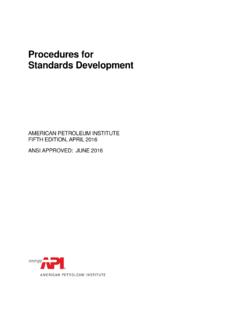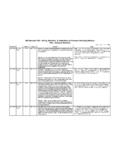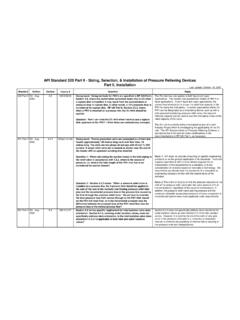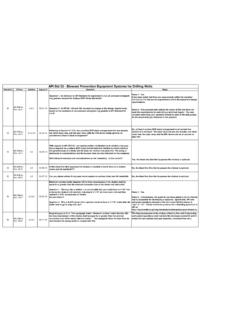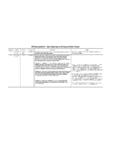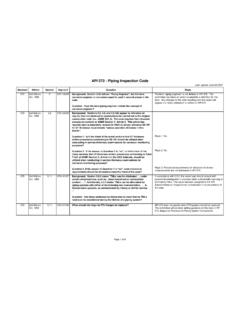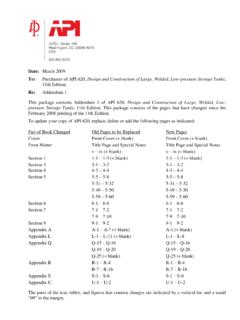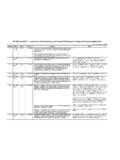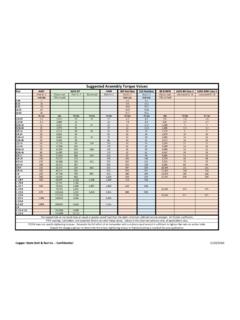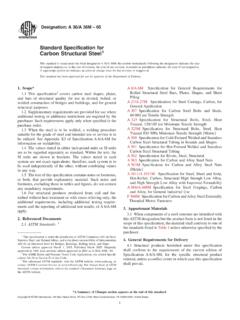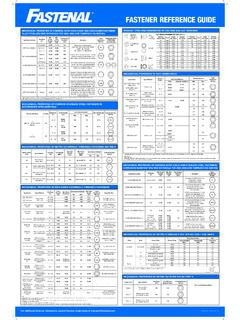Transcription of API Specification 20E
1 API Specification 20E Alloy and Carbon Steel Bolting for Use in the Petroleum and Natural Gas Industries FIRST EDITION | AUGUST 2012 | 19 PAGES | $ | PRODUCT NO. G20E01 This standard specifies requirements for the qualification, production and documentation of alloy and carbon steel bolting used in the petroleum and natural gas industries. This standard applies when referenced by an applicable API equipment standard or otherwise specified as a requirement for compliance. An annex for supplemental requirements that may be invoked by the purchaser is included. This standard establishes requirements for three bolting Specification levels (BSL).
2 These three BSL designations define different levels of technical, quality and qualification requirements, BSL-1, BSL-2, and BSL-3. The BSLs are numbered in increasing levels of severity in order to reflect increasing technical, quality and qualification criteria. This standard covers the following finished product forms, processes, and sizes: a)machined studs; b)machined bolts, screws and nuts ; c)cold formed bolts, screws, and nuts (BSL-1 only); d)hot formed bolts and screws < in. ( mm) nominal diameter; e)hot formed bolts and screws in. ( mm) nominal diameter; f)roll threaded studs, bolts, and screws < in. ( mm) diameter; g)roll threaded studs, bolts, and screws in.
3 ( mm) diameter; h)hot formed nuts < in. ( mm) nominal diameter; i)hot formed nuts in. ( mm) nominal diameter. For ordering information: Online: Phone: 1-800-854-7179 (Toll-free in the and Canada) (+1) 303-397-7056 (Local and International) Fax: (+1) 303-397-2740 API members receive a 30% discount where applicable. Tom Goin TSP / US bolt Director of Sales and Supply Chain Programs, Chair of AWHEM Bolting Task Group and API SC 20E on Bolting Lester Burgess TSP / US bolt Director of Quality and Technical Services, Chair of ASTM Subcommittee on Steel Testing and ASTM on High Pressure / High Temperature Bolting API product specifications traditionally reference ASTM specifications for bolting ASTM bolting standards are material specifications ASTM A01 bolting specifications are primarily directed toward pressure vessel and piping applications ASTM does not have enforcement power Subsea bolting failures lead to huge financial losses Reaction was introduction of multiple OEM and User specifications adding testing and procurement requirements to ASTM specifications AWHEM standard developed to combine requirements published as
4 Technical guide API SC 20 on Supply Chain requested development of a true API Specification for bolting. Purpose: This API standard specifies requirements for the qualification, production and documentation of alloy and carbon steel bolting used in the petroleum and natural gas industries. ASTM A193 Grades B7 and B7M; ASTM A194 Grades 2H, 4, 7, 2HM and 7M; ASTM A320 Grades L7, L7M, and L43; ASTM A540 Grades B22 and B23. 20E has no design authority. Implementation is to be done by designer, or purchaser Should be applicable to Christmas trees, blow-out preventers, sub-sea pumps, wellhead connectors, hydraulic tensioning systems, drilling risers, etc.
5 This API Standard establishes requirements for three bolting Specification levels (BSL). These three BSL designations define different levels of technical, quality and qualification requirements: BSL-1, BSL-2 and BSL-3. The BSLs are numbered in increasing levels of severity in order to reflect increasing technical, quality and qualification criteria. It is anticipated that BSL3 would be adopted for critical-service, highly stressed structural or pressure-boundary applications machined studs; machined bolts, screws and nuts ; cold formed bolts, screws and nuts (BSL-1 only); hot formed bolts and screws < in. ( ) nominal diameter; hot formed bolts and screws in.
6 ( ) nominal diameter; roll threaded studs, bolts, and screws < in. ( ) diameter; roll threaded studs, bolts, and screws in. ( ) diameter; hot formed nuts < in. ( ) nominal diameter; hot formed nuts in. ( ) nominal diameter. Qualification Testing Each category of Bolting type to be qualified. Qualification bolting shall be tested and evaluated by the bolting manufacturer in order to establish qualification to the bolting types listed in and a BSL. Qualification bolting shall meet all of the requirements indicated in Table 1 for the applicable sections of this standard. Table 1 Bolting Test Requirements BSL Material heat Treat Chemistry Mechanical Metallurgical Hardness NDE Surface NDE Volumetric BSL-1 --- BSL-2 --- BSL-3 All required tests, including those certified by the raw material supplier, shall be performed by a laboratory qualified in accordance with an internationally recognized international standard for the qualification of test laboratories, such as ISO 17025.
7 Qualification may be performed on parts specifically manufactured for qualification or random parts selected from a production lot. A sufficient number of parts shall be used to provide adequate material for all required tests. The manufacturer shall retain and have available a MPS (see ) and qualification records (see ) for each product qualified. The qualification records shall show all of the products, processes and sizes qualified and all of the Table 1 requirements for each qualification including the results of tests and inspections. Excessive hardness heat treatment Microstructure Chemistry Internal forging defects/bursts Forging cracks ( nuts ) Over-tapped threads ( nuts ) Thread rolling bursts BSL-1 The steel shall be fully wrought.
8 The reduction ratio based on starting material diameter shall be a minimum of 4:1. The steel shall conform to the requirements of the standards listed in , as applicable. Intentional additions of boron are not allowed. All elements intentionally added to the heat shall be reported. BSL-2 The requirements specified for BSL-1 are required for BSL-2. Melting method of the raw material shall be fine grain practice as defined by ASTM A941. Steel shall be produced by electric furnace or vacuum induction melting followed by secondary refining practices or ladle refining. The allowable sulfur content shall be .025% maximum and the allowable phosphorus content shall be.
9 025% maximum. Residual boron content shall not exceed .0005%. BSL-3 The requirements specified for BSL-2 are required for BSL-3 except as specified below. The reduction ratio based on starting material diameter shall be 10:1 minimum. Allowable sulfur content shall be .015% maximum and the allowable phosphorus content shall be .015% maximum. The continuous cast steel making process is prohibited. In addition to the heat analysis performed by the raw material supplier, the bolting manufacturer shall perform a product analysis in accordance with ASTM A29..The bolting manufacturer shall prepare a manufacturing procedure Specification (MPS) to include, as a minimum allowable levels for all bolting manufacturing parameters including the process control variables listed in and the heat treatment parameters listed in General Variables heading equipment; hot forming heating method; hot forming temperature control method; machining and threading equipment: single point (lathe), multiple chaser, roll, tap; machining and threading control methods.
10 heat Treatment Parameters The following are heat treat parameters, as applicable: equipment (batch, continuous, induction, direct resistance); times and temperatures; cooling media ( type, polymer concentration, quench temperature, agitation); control and calibration methods; maximum transfer time; quench media start and finish temperature; furnace load diagrams. Advantage radial grain flow Improper processing can lead to service failure Need for control Heating Dimensional control Die wear BSL-2 Requirements Requirements specified for BSL-1 are required for BSL-2. ASTM A320 Grade L43 and ASTM A540, Grade B23 material shall be double tempered.
